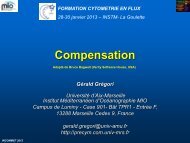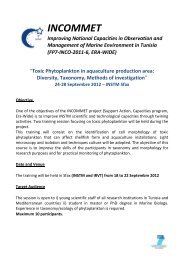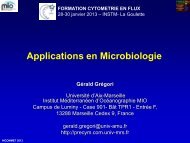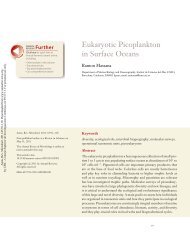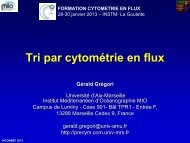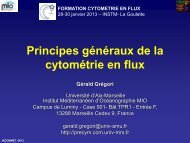Phytoplankton Cell Counting by Flow Cytometry - incommet
Phytoplankton Cell Counting by Flow Cytometry - incommet
Phytoplankton Cell Counting by Flow Cytometry - incommet
Create successful ePaper yourself
Turn your PDF publications into a flip-book with our unique Google optimized e-Paper software.
AAC17 9/24/04 03:47 PM Page 3<strong>Phytoplankton</strong> <strong>Cell</strong> <strong>Counting</strong> <strong>by</strong> <strong>Flow</strong> <strong>Cytometry</strong> 3be applied equally well to field samples and to freshwaterorganisms. In the latter case, only obvious modifications,such as replacing seawater wherever mentioned<strong>by</strong> freshwater, are required (Lebaron et al. 2001,Crosbie et al. 2003).2.0. Principles of <strong>Flow</strong> <strong>Cytometry</strong>2.1. General PrinciplesFCM measures cells in liquid suspension. <strong>Cell</strong>s arealigned hydrodynamically <strong>by</strong> an entrainment fluid(sheath fluid) into a very narrow stream, 10 to 20 mmwide, onto which one or several powerful light sources(arc mercury lamp or laser) are focused. Each time aparticle passes through the beam, it scatters light;angular intensity depends on the refractive index,size, and shape of the particle. Moreover, if the particlecontains a fluorescent compound whose absorptionspectrum corresponds to the excitation source (e.g.,blue light for chlorophyll), it emits fluorescence at ahigher wavelength (e.g., red light for chlorophyll).These light pulses are detected <strong>by</strong> photodiodes or moreoften <strong>by</strong> photomultipliers and then are converted todigital signals that are processed <strong>by</strong> a computer. Measurementrates vary between 10 and 10,000 events persecond. On the more sophisticated instruments, it isthen possible to physically sort cells of interest based onany combination of the measured parameters (seeChapter 7).2.2. Fluidics<strong>Flow</strong> cytometers are equipped with a tank supplying thesheath liquid (buffer, distilled water, seawater) thatcarries the cells through the instrument; a second tankcollects the waste fluid. <strong>Cell</strong> suspensions are injected orpushed through a capillary into a sheath fluid stream.Under laminar flow conditions, the sheath liquid alignsthe cells into a narrow centered stream. The illuminationof cells can be performed in the air, just outside anozzle through which the sheath fluid exits, or in aquartz cuvette through which the sheath fluid flows.The latter solution increases the detection sensitivity,which is required for picophytoplankton. The flow ratemust be adjusted depending on the cells of interest tokeep laminar flow conditions and to control the numberof events to be analyzed per unit time.2.3. OpticsWhen a particle passes through the excitation beam,light can be reflected or refracted. In most flow cytometers,the light scatter detectors are located at 180°(forward scatter or FSC) and at 90° (side scatter or SSC)with respect to the light source. Both parameters arerelated to cell size, but the side scatter is more influenced<strong>by</strong> the cell surface and internal cellular structure(Morel 1991, Green et al. 2003).Many fluorescent molecules can bind to a widerange of cytochemical compounds such as proteins,lipids, or nucleic acids. Each fluorescent dye ischaracterized <strong>by</strong> its excitation and emission spectra.<strong>Flow</strong> cytometers are usually equipped with a laser emittingat a single wavelength (488 nm). Therefore, onlyfluorescent molecules excited at that particular wavelengthcan be used. If multiple excitation wavelengthsare available, then the choice of the fluorochromes ismuch wider.The flow cytometer is equipped with highly sensitivephotomultiplier tubes that are able to measure andamplify the brief pulse of light emitted <strong>by</strong> the cells.When a cell intersects the excitation beam, the emittedlight is collected <strong>by</strong> a lens and passes through a seriesof filters that remove the excitation light, allowing onlythe emission light to be detected. With several photomultipliers,multiple wavelength emission ranges can becollected (e.g., orange and red fluorescence for algalcells).2.4. Electronic and Software ProcessingTo be usable, analog data from the photomultipliersmust be converted to digital form, that is, to a numberon a scale ranging, for example, from 1 to 256 (2 8 ) correspondingto 8-bit conversion. To avoid saturation ofthe conversion circuitry, only events of interest must beconverted. Therefore, the operator needs to select oneor several signals (called discriminators or triggers) andmust set thresholds for each discriminator. Whenthe value of one of the discriminator signals is largerthan the corresponding threshold, all signals from thetriggering particle are converted. Choosing adequatediscriminators and thresholds is critical to correctlyrecord the cells of interest, especially when workingwith very small cells or particles. As an example, torecord chlorophyll fluorescing microalgae, it is bestto choose red fluorescence as the discriminator andto select a threshold that is high enough so optical and



